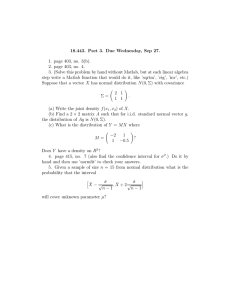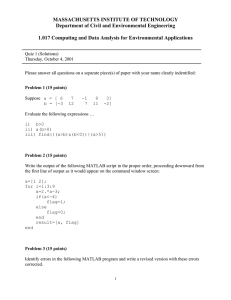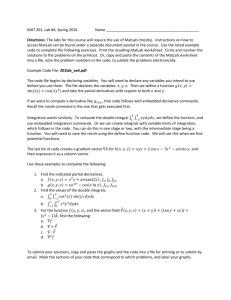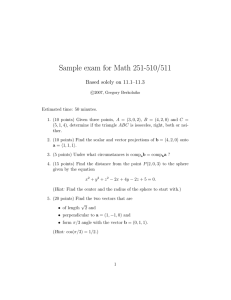Document 13666510
advertisement
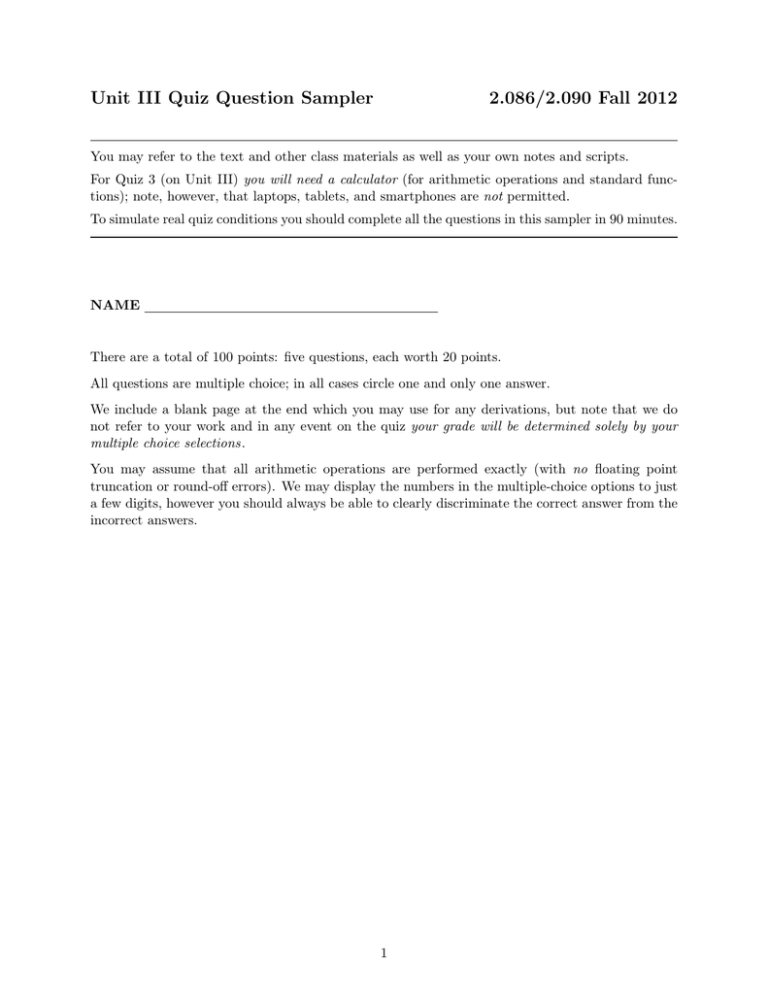
Unit III Quiz Question Sampler 2.086/2.090 Fall 2012 You may refer to the text and other class materials as well as your own notes and scripts. For Quiz 3 (on Unit III) you will need a calculator (for arithmetic operations and standard func­ tions); note, however, that laptops, tablets, and smartphones are not permitted. To simulate real quiz conditions you should complete all the questions in this sampler in 90 minutes. NAME There are a total of 100 points: five questions, each worth 20 points. All questions are multiple choice; in all cases circle one and only one answer. We include a blank page at the end which you may use for any derivations, but note that we do not refer to your work and in any event on the quiz your grade will be determined solely by your multiple choice selections. You may assume that all arithmetic operations are performed exactly (with no floating point truncation or round-off errors). We may display the numbers in the multiple-choice options to just a few digits, however you should always be able to clearly discriminate the correct answer from the incorrect answers. 1 Question 1 (20 points) You are given a matrix u of size 4 × 1, ⎛ 2 ⎜ 1 ⎜ u = ⎜ ⎝ 1 1 ⎞ ⎟ ⎟ ⎟ , ⎠ in Matlab u = [2;1;1;1], and a second matrix v of size 4 × 1, ⎛ 1 2 ⎞ ⎜ ⎟ ⎜ 1 ⎟ v = ⎜ ⎟ , ⎝ 0 ⎠ 0 in Matlab v = [0.5;1;0;0]. Here the size of a matrix, m × n, refers to the number of rows (m) and number of columns (n) in the matrix. (In order to avoid any ambiguity we shall refer solely to matrices in this question, although of course some of the entities are vectors.) We now perform the matrix-matrix product “u times v T ,” w = u(v T ) , where recall that T denotes transpose. (i ) (3 points) The size of the matrix w is (a) 1 × 1 (b) 1 × 4 (c) 4 × 4 (d ) 4 × 1 (ii ) (3 points) The operation of equation (1) is implemented in Matlab as (a) w = u.*v (b) w = v.*u (c) w = u'*v (d ) w = u*v' 2 (1) (iii ) (4 points) The value of w(1,1) is (a) 0.5 (b) 1.0 (c) 2.5 (d ) 2.0 We now perform the matrix-matrix product “uT times v,” z = (uT )v , where again T denotes transpose. (iv ) (3 points) The size of the matrix z is (a) 1 × 1 (b) 1 × 4 (c) 4 × 4 (d ) 4 × 1 (v ) (3 points) The operation of equation (2) is implemented in Matlab as (a) z = u.*v (b) z = v.*u (c) z = u'*v (d ) z = u*v' (vi ) (4 points) The value of z(1,1) is (a) 0.5 (b) 1.0 (c) 2.5 (d ) 2.0 3 (2) Question 2 (20 points) We run the script % begin script clear n = 1000; A = zeros(1000,1000); A(400,404) A(678,2) = A(678,999) A(705,678) A(705,999) = 1.0; 8.0; = 4.0; = 2.0; = 10.0; w = ones(1000,1); v = A*w; % end script Note that A is a 1,000 × 1,000 matrix with only five non-zero entries, and that w is a 1,000 × 1 vector of all ones. (i ) (5 points) The value of v(678) is (a) 0 (b) 8 (c) 12 (d ) 14 Hint: Consider the “row interpretation” of the matrix-vector product. (ii ) (5 points) The value of v(999) is (a) 0 (b) 8 (c) 12 (d ) 14 Hint: Consider the “row interpretation” of the matrix-vector product. 4 We (now clear all variables and) define a w (in Matlab, w) as ⎛ 1 2 3 ⎜ 1 2 3 ⎜ ⎜ ⎜ 1 2 3 ⎜ ⎜ ⎜ ⎜ B = ⎜ ⎜ ⎜ .. .. .. ⎜ . . . ⎜ ⎜ ⎜ ⎜ ⎝ 1 2 3 1,000 × 5 matrix B (in Matlab, B) and a 5 × 1 vector ⎞ 4 5 4 5 ⎟ ⎟ ⎟ 4 5 ⎟ ⎟ ⎟ ⎟ ⎟ ⎟, ⎟ ⎟ .. . . . . ⎟ ⎟ ⎟ ⎟ ⎟ ⎠ 4 5 ⎛ ⎞ 0 ⎟ ⎜ ⎜ 0 ⎟ ⎟ ⎜ ⎟ w = ⎜ ⎜ 1 ⎟ , ⎟ ⎜ ⎝ 0 ⎠ −1 (the j th column of B consists of “all j’s”). We then evaluate v = Bw and find the maximum of the vector v as M= max vi . 1≤i≤1000 (3) If you wish to see the corresponding Matlab script, refer to Appendix A at the end of the sampler. (iii ) (10 points) The value of M from equation (3) is (a) -2 (b) 0 (c) 2 (d ) 4 (e) 5 Hint: Consider the “column interpretation” of the matrix-vector product. 5 Question 3 (20 points) We consider linear regression for a particular simple case: a single independent variable (p = 1), which we denote x; as always, a single dependent variable, y; a model with only n = 2 terms, Ymodel (x; β) = β0 + β1 x , (4) (hence h0 (x) = 1, h1 (x) = x); and m = 3 noisy measurements given by (x1 = 0, Y1 = 0), (x2 = 1, Y2 = 0), (x3 = 2, Y3 = 2). We denote by Y the 3 × 1 column vector (0 0 2)T , and by β the 2 × 1 column vector (β0 β1 )T . (i ) (3 points) The “regression matrix” X is given by 1 1 1 0 1 2 (a) ⎛ ⎞ 1 0 (b) ⎝ 1 1 ⎠ 1 2 ⎛ ⎞ 1 0 (c) ⎝ 1 0 ⎠ 1 2 (d ) 0 1 2 0 0 2 Recall that (Xβ)i (the ith component of the vector Xβ) is equal to Ymodel (xi ; β) for the measurement points xi , i = 1, 2, 3. (ii ) (3 points) The equation Xβ = Y (5) has, for our particular (noisy) measurements and hence Y vector (0 0 2)T indicated above, (a) no solution for β (b) a unique solution for β (c) many solutions for β Hint: Consider the relationship of equation (5) to the problem of putting a straight line through three points; plot the experimental data (xi , Yi ), i = 1, 2, 3. 6 (iii ) (5 points) ⎛ 1 (a) ⎝ 1 1 The matrix X T X is given by ⎞ 1 1 2 3 ⎠ 3 5 3 3 3 5 (b) ⎛ ⎞ 0 0 (c) ⎝ 1 1 ⎠ 1 4 3 2 2 4 (d ) (iv ) (4 points) The matrix X T Y is given by (a) 3 9 (b) 4 7 (c) 2 4 ⎛ ⎞ 0 (d ) ⎝ 1 ⎠ 2 (v ) (5 points) The least squares solution β̂ to our problem is (a) β̂0 = −0.3333 , β̂1 = 1.0 (b) β̂0 = −0.1667 , β̂1 = 1.5 (c) β̂0 = 0 , β̂1 = 1.0 (d ) β̂0 = −0.5 , β̂1 = 1.2 (Recall that the least-squares solution β̂ is the particular β which minimizes the norm of the residual squared (i.e., IY − XβI2 ).) Hint: Recall the simple formula for the inverse of a 2 × 2 matrix. 7 Question 4 (20 points) A naturalist studying a pair of geese devises a camouflaged scale to provide weight data for each of the geese (henceforth denoted Goose 1 and Goose 2). Sometimes a single goose will walk onto the scale but on other occasions both geese walk onto the scale at the same time. On a given day the naturalist records in the logbook Observation 1: Goose 1 on scale; scale transducer indicates 12.3 kilos. Observation 2: Goose 1 and Goose 2 on scale; scale transducer indicates 26.3 kilos. Observation 3: Goose 2 on scale; scale transducer indicates 13.1 kilos. We wish to infer from this data a good estimate for the weights of each of the geese. In what follows we shall denote by W1 the weight of Goose 1 (in kilos) and by W2 the weight of Goose 2 (in kilos); we further denote by W the 2 × 1 vector W1 W ≡ . (6) W2 We further define the 3 × 1 vector of scale readings ⎛ ⎞ 12.3 S ≡ ⎝ 26.3 ⎠ 13.1 (7) (where again the units are kilos). The naturalist’s three observations above can be summarized as BW = S + E, (8) where B is a matrix and E is a 3 × 1 noise vector. We shall assume that the noise vector E (in kilos) relates to transducer error and does not depend on the weight on the scale. (i ) (8 points) The matrix B is given by ⎛ ⎞ 12.3 0 (a) ⎝ 26.3 26.3 ⎠ 0 13.1 ⎛ ⎞ 1 0 ⎝ 1 1 ⎠ (b) 0 1 ⎛ ⎞ 12.3 0 −1 (c) ⎝ 26.3 26.3 −2 ⎠ 0 13.1 −1 ⎛ ⎞ 1 0 (d ) ⎝ 1 −1 ⎠ 1 0 (ii ) (4 points) The matrix equation (system of linear equations) BW = S has 8 (a) a unique solution for W (b) no solution for W (c) many solutions for W ˆ which (iii ) (8 points) The weight vector W minimizes the norm of the residual squared, IS − BW I2 , over all vectors W satisfies the linear system of equations 2 1 12.3 (a) W = 1 2 26.3 2 1 38.6 (b) W = 1 2 39.4 1 0 12.3 (c) W = 1 1 26.3 1 0 38.6 (d ) W = 1 1 39.4 9 Question 5 (20 points) The average skin friction coefficient (nondimensional and positive), C f , for a turbulent boundary layer depends on the Reynolds number (nondimensional and positive), Re, as C f = α(Reρ ) , (9) where α and ρ are unknown constants (i.e., which do not depend on Re). Note that α is a positive multiplicative factor and ρ is the exponent of Re. The above form would lead to a nonlinear regression problem. We thus define y = log(C f ) and x = log(Re) such that now y may be expressed as y = Ymodel (x; β) with (10) Ymodel (x; β) = β0 + β1 x for β0 and β1 independent of x. Here log refers to the natural logarithm (with corresponding Matlab built-in function log). This form, you will agree, is amenable to linear regression analysis. We shall assume that the model of equation (10) is bias-free: there exists a unique β true ≡ (β0true β1true )T such that equation (10) exactly predicts log(C f ). We further provide m×1 arrays xpts (values of log(Re)) and Y (values of log(C f )) corresponding to (noisy) measurements (xpts(i), Y(i)), 1 ≤ i ≤ m, for m = 52. We assume that the measurements are given by Y(i) = Ymodel (xpts(i); β true ) + E(i), 1 ≤ i ≤ m , where the noise E(i) satisfies our assumptions N1, N2, and N3 (normal zero-mean, homoscedastic with standard deviation σ, uncorrelated in x). We now run the script∗ % begin script m = 52; X = [ones(m,1), xpts]; betahat = X \ Y; % end script (i ) (5 points) Based on the regression analysis above, our estimate for α is (a) betahat(1) (b) exp(betahat(1)) (c) log(betahat(1)) (d ) -betahat(1) where exp is the Matlab built-in exponential function. Hint: Consider the log transformation of equation (9) to equation (10). ∗ Note that prior to running the script the Matlab workspace contains only xpts and Y. 10 (ii ) (5 points) Based on the regression analysis above, our estimate for ρ is (a) betahat(2) (b) exp(betahat(2)) (c) log(betahat(2)) (d ) -betahat(2) Hint: Consider the log transformation of equation (9) to equation (10). (iii ) (5 points) We now calculate, based on the data provided, joint 0.95-confidence-level confidence intervals for β0true and β1true , I0joint and I1joint , respectively. We obtain for I1joint (the confidence interval for β1true ) the interval [−0.1560, −0.1262]. With confidence level 0.95 we may then conclude that (over the range of Re covered by the experimental data) (a) C f increases with increasing Re (b) C f decreases with increasing Re (c) C f is independent of Re (d ) C f is always negative (iv ) (5 points) The length of the confidence interval of Question 5(iii ) is deemed too large and hence the accuracy of our β1true estimate potentially too low. To remedy the situation you should (a) increase the number of measurements from m = 52 to mnew (> m), and then re-perform the regression analysis (b) retain the m = 52 measurements but replace the model of equation (10) (which has n = 2 terms) by a new model (which has n = 52 terms) new Ymodel (x; β) = 51 5 βj x j (= β0 + β1 x + · · · + β51 x51 ) , j=0 and then re-perform the regression analysis 11 Appendix A Matlab Script for Question 2(iii ) % begin script clear m = 1000; B = zeros(1000,5); for i = 1:m for j = 1:5 B(i,j) = j; end end w = zeros(5,1); w(3) = 1.0; w(5) = -1.0; v = B*w; M = max(v); % end script where max is the Matlab built-in function which returns the maximum of a vector. 12 Answer Key Q1 (i ) (c) 4 × 4 (ii ) (d) w = u*v' (iii ) (b) 1.0 (iv ) (a) 1 × 1 (v ) (c) z = u'*v (vi ) (d) 2.0 Q2 (i ) (c) 12 (ii ) (a) 0 (iii ) (a) −2 ⎛ Q3 ⎞ 1 0 (i ) (b) ⎝ 1 1 ⎠ 1 2 (ii ) (a) no solution for β 3 3 (iii ) (b) 3 5 2 (iv ) (c) 4 (v ) (a) β̂0 = −0.3333, β̂1 = 1.0 ⎛ ⎞ 1 0 Q4 (i ) (b) ⎝ 1 1 ⎠ 0 1 (ii ) (b) no solution for W 2 1 38.6 (iii ) (b) W = , 1 2 39.4 Q5 (i ) (b) exp(betahat(1)) (ii ) (a) betahat(2) (iii ) (b) C f decreases with increasing Re (iv ) (a) increase the number of measurements 13 MIT OpenCourseWare http://ocw.mit.edu 2.086 Numerical Computation for Mechanical Engineers Fall 2012 For information about citing these materials or our Terms of Use, visit: http://ocw.mit.edu/terms.
